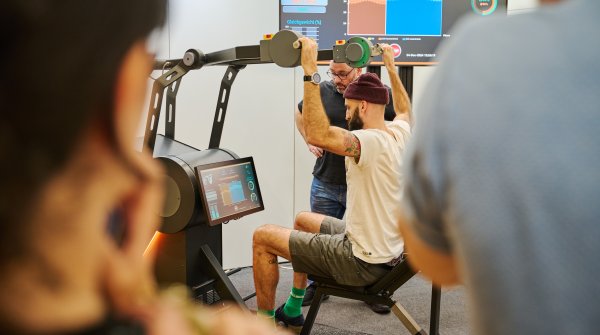The multiple Ironman winner has tailored her training to her cycle and is open about her experiences with it. The 35-year-old tells us her tips on how athletes can avoid mistakes in training and optimize their performance in line with their cycles.
Women simply tick differently than men, at least hormonally speaking. The female hormone level is subject to greater fluctuations in the course of a cycle, unless contraception is used with artificial hormones such as the birth control pill.

According to studies, the different hormone levels during the course of the month can affect body temperature or blood pressure, but also performance during and the ability to recover after sports. after sports. The same applies to the risk of injury. In some phases, female athletes recover faster, perform better and are more resistant to physical stress. In cycle-based training, it is precisely these different phases that are taken into account and the training plan is individually adapted accordingly.
Since the winter of 2019, Laura Philipp, together with her coach and husband, has tried a lot and read up a lot on the subject. "For me, the most important step was to start cycle tracking, taking my temperature and observing my body every day. In doing so, I wanted to determine which training sessions or even everyday influences, for example, if I slept poorly, affected my body and how."
Fasting training, a standard measure to improve fat metabolism, was one training session, for example, which she subsequently omitted because it is not necessarily goal-oriented in women and is rather detrimental to their health. According to performance diagnostics, this step also did not lead to any lasting losses in her fat metabolism.

Roughly speaking, the female cycle can be divided into two phases. A healthy cycle begins in the first half of the cycle with menstruation. It ends with ovulation, which then initiates the second half of the cycle. This in turn lasts until the menstruation of the next cycle begins.
For all those who want to remember in more detail how the female cycle works, triathlete Laura Philipp also explains the course and the different cycle phases on her YouTube channel.
In terms of training, these different phases are related to performance. In the first half of the cycle, based on hormone levels such as a lower estrogen level, it is assumed that performance is higher. The female body regenerates faster or needs less sleep. In the second half, performance decreases the closer one gets to the next menstrual period. The body has an increased energy requirement, regenerates more slowly and is also more susceptible to injury. In addition, PMS, pain and mood swings can occur in the days leading up to menstruation.
It is the same during the period in the first half of the cycle. However, this is also very individual and varies from woman to woman. Pain or other discomfort affects everyone differently. At the same time, from a sports science point of view, there are unfortunately no broad studies on the subject. So there is no template that fits every female athlete. Nevertheless, certain regularities can be identified in women who record their cycle as well as training and health data. As a professional triathlete, Laura Philipp uses this knowledge to adapt her training accordingly.

But what about during menstruation? Because menstruation is actually part of the more powerful first half of the cycle. So for many female athletes, a performance peak only begins after menstruation, when cramps, back pain or headaches also subside. But it also depends on each individual. Period pain is not the same every month, nor is every menstruating person equally affected by it.
According to studies, loose exercise during menstruation can do good and work against cramps and period pains. But here, too, you should pay attention to your own body and what is good for you and what is not. So if in doubt, it's better to squeeze in a loose session or a bit of yoga than to ignore your body's signs and go through with a hardcore workout despite feeling physically unwell. The same applies to the second half of the cycle, because here it is just as important to pay attention to your physical needs and take proper care of your body. Particularly in the second half of the cycle, Laura eats more carbohydrates in order to supply her body even better and thus keep it more efficient. Before and during the first days of her period, she also avoids certain foods, such as milk and caffeine, which cause her to have more cramps.

Although about half the population menstruates and is affected by fluctuating performance due to their cycle, the topic is far from reaching the mainstream of competitive or professional sports.
"Whether it's a cycle or a period, as an athlete you always feel a bit vulnerable when you talk about it, and it feels a bit like a weakness to say that you couldn't perform because of it," says Laura Philipp. Laura has trained like a man for a long time - based on classic findings from sports science that are heavily male-focused. Competitive sports and the associated training are a heavy burden, especially in the endurance area, which can sometimes affect fertility and also lead to a lack of menstruation.
"Especially when I run an Ironman, it puts extreme stress on the body. It's in a state of war, so to speak, and has completely different things to do than worry about fertility." A functioning cycle is therefore not a matter of course in endurance sports. Despite her hard training, Laura's goal is always to have a healthy cycle and avoid missing her period. "As athletes and women, we have a kind of built-in early warning system that kicks in if we're putting too much on the body and overloading it." So all in all, the female cycle definitely has a positive connotation for Laura.

Even if more and more women in top-class sports are admitting to their menstrual pain: "It's a topic that is now being brought more and more into the public eye, but also one that still feels a bit like a taboo subject." She says it's still not easy for many women to talk about their menstruation in public and to be open about it when it temporarily prevents them from performing well in important competitions, for example.
Even if you know and observe your body, important competitions, championships or decisive races can unfortunately not be scheduled so that they fall into the physical peak phase. In order to still be able to successfully complete competitions on bad days, Laura pays more attention to her nutrition and regeneration.
To optimize her training, Laura measures her daily basal body temperature and tracks other values with a fitness tracker. She uses Whoop's wearable fitness and health coach for this purpose. The wearable measures various values 24/7 and provides useful insights into stress, recovery and sleep data. It also offers integrated menstrual cycle coaching. Laura records menstruation, complaints and observations in a kind of logbook in the app and receives recommendations for training based on this.
This data can be evaluated more and more precisely the longer it is tracked and the coach function is used. In addition, female athletes recognize recurring monthly fluctuations in the course of their cycle over the long term. "For all those who are dealing with this for the first time, the tracker thus offers an easy introduction to the topic," says Laura Philipp. And even if you don't want to think about taking your temperature every day at first.
Laura Philipp shares more information about cycle-based training on her blog.
- Awards
- Mountain sports
- Bike
- Fitness
- Health
- ISPO Munich
- Running
- Brands
- Sustainability
- Olympia
- OutDoor
- Promotion
- Sports Business
- Textrends
- Triathlon
- Water sports
- Winter sports
- eSports
- SportsTech
- OutDoor by ISPO
- Heroes
- Transformation
- Sport Fashion
- Urban Culture
- Challenges of a CEO
- Trade fairs
- Sports
- Find the Balance
- Product reviews
- Newsletter Exclusive Area
- Magazine







